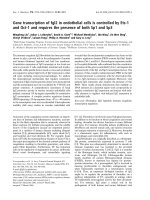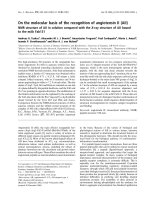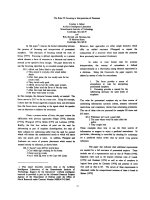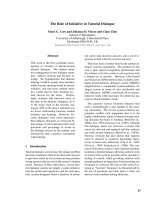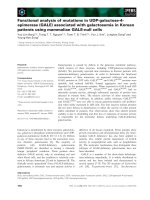Báo cáo khoa học: "Nondrug costs of therapy in acute care – are they important" ppsx
Bạn đang xem bản rút gọn của tài liệu. Xem và tải ngay bản đầy đủ của tài liệu tại đây (31.53 KB, 2 trang )
420
ICU = intensive care unit.
Critical Care December 2003 Vol 7 No 6 Edbrooke and Bourne
This issue of Critical Care includes an article by van Zanten
and colleagues [1] on the nondrug costs associated with the
administration of intravenous antibiotic therapy. The study
highlights the fact that the acquisition costs (the costs of the
drug itself) are only a proportion of the total costs. The
additional costs of administration may be up to 53% of the
daily costs of antibiotic therapy. There is no reason to doubt
the results of this detailed study, which included accurate
measurement of costs.
A more important philosophical question is what are the
relevance of these costs? The more sanguine among us may
well argue that the nurses and doctors are on the intensive
care unit (ICU) anyway, and therefore their costs are not
relevant. However, costs have a direct link with three other
areas that have an impact in the ICU, namely resources,
quality of care and the impact on the gross spending on
health care in the country.
There is no doubt that spending within any area of health care,
including the ICU, has limitations. This is well illustrated by the
recent introduction of drotrecogin alfa (activated) in severe
sepsis [2]. Although the cost per treatment might seem high,
cost-effectiveness studies have provided justification for its
use [3,4]. In contrast are the findings of a study that
addressed the use of respirators to prevent acquisition of
tuberculosis by hospital workers [5]. It showed that with use
of a simple mask, costing approximately €7.5 each, 41 years
would have to pass for one worker to acquire tuberculosis,
yielding a cost-effectiveness ratio of €0.85–15 million. In
other words, despite its low cost it gave poor value for money.
Every cost implies the use of resources, be they staff, drugs, or
equipment. Cost can vary from city to city or from country to
country but the resource use may well stay the same. So,
although the study conducted by van Zanten and coworkers
[1] reports the results in cost units, there are implications for
the use of resources. For example, the cost of a nurse in
France may be €48000 per annum, whereas it is €6500 per
annum in Hungary (Guidet B, Csosmos A, personal
communication). However, the resources remain constant.
Thus, the preparation costs reported in the study by van
Zanten and colleagues represents a proportion of the use of
resources. Although the proportion may not be large, it is
important for us to reflect on what we require of a nurse or
doctor’s time in the ICU environment. For example, the
increased use of pharmacy additive services will decrease the
time that nursing staff spend on indirect patient care, thereby
allowing an increase in the time available for direct patient care.
We believe that this time would best be employed in direct
patient care. Taking the argument to extremes, if only 50% of
Commentary
Nondrug costs of therapy in acute care – are they important?
David L Edbrooke
1
and Richard S Bourne
2
1
Consultant in Intensive Care, Royal Hallamshire Hospital, and Medical Economics and Research Centre, Sheffield, UK
2
Critical Care Pharmacist, Royal Hallamshire Hospital, Sheffield, UK
Correspondence: David L Edbrooke,
Published online: 6 November 2003 Critical Care 2003, 7:420-421 (DOI 10.1186/cc2403)
This article is online at />© 2003 BioMed Central Ltd (Print ISSN 1364-8535; Online ISSN 1466-609X)
Abstract
Drug acquisition costs are only a proportion of the total costs associated with drug therapy. The
relevance of these costs are often not appreciated. However, they impact on the Intensive Care Unit
via resources and quality of care. Increased indirect care by medical and nursing staff has the potential
to adversely affect patient outcome. Redirecting staff to their primary role and reducing indirect patient
activities will increase quality and allow more patients to be treated. Costs and resources are
increasingly important in health care provision.
Keywords drug costs, indirect costs, patient care, personnel costs
421
Available online />a nurse’s or doctor’s time were spent in duties other than
direct patient care, then this must have a deleterious effect on
the care of the patient, difficult though this may be to prove.
This effect could well be defined under the heading of quality
of care, which is, as yet, difficult to quantify. A good example
of the effect of diminished quality of care is illustrated by an
elegant study of the effect of quality of nursing care on
duration of weaning from mechanical ventilation [6]. That
study demonstrated that as the quality of nursing care was
reduced the duration of weaning was increased, but when
the quality of nursing staff was improved the weaning time
dramatically decreased. However, improvement in quality is
only possible via the increased cost (and resource use)
associated with this change.
Finally, it is clear that the demand for health care resources
(and thus cost) is outstripping the supply in most countries
throughout the world [7]. The implication of this is the
necessity of ICUs to utilize their resources wisely. This is not
a short-term problem that will have an effect within the next
year, but rather over the next few years most countries will be
reforming their health care services in an attempt to limit
costs escalating. ICUs will not be immune from this, and it is
therefore in our own interests to take responsibility for using
resources wisely. Our objective should not be to reduce cost
per se but to reduce wasted resources so that we will have
the ability to treat more patients. We can only achieve that if
we are willing to accept that this role is as important as our
better defined clinical role.
In conclusion, although the time spent on nondrug costs of
intravenous antibiotic therapy may seem relatively
insignificant, consideration of the costs and resources are
important if we are to give the most benefit to the greatest
number of patients in the future. The subjects of cost and
resource use are now beginning to be recognized by more
clinicians and not dismissed as being outside the remit of our
function as clinicians. Perhaps, then, the eloquent words of
Sir Winston Churchill are relevant: “We are not at the end,
nor at the beginning, we are not at the beginning of the end
but perhaps we are at the end of the beginning”.
Competing interests
None declared.
References
1. van Zanten ARH, Engelfriet PM, van Dillen K, van Veen M, Nuijten
MJC, Polderman KH: Importance of nondrug costs of intra-
venous antibiotic therapy. Crit Care 2003, 7:R184-R190.
2. Bernard GR, Vincent JL, Laterre PF, LaRosa SP, Dhainaut JF,
Lopez-Rodriguez A, Steingrub JS, Garber GE, Helterbrand JD, Ely
EW, Fisher CJ Jr, Recombinant human protein C Worldwide Eval-
uation in Severe Sepsis (PROWESS) study group: Efficacy and
safety of recombinant human activated protein C for severe
sepsis. N Engl J Med 2001, 344:699-709.
3. Angus DC, Linde-Zwirble WT, Clermont G, Ball DE, Basson BR,
Ely EW, Laterre PF, Vincent JL, Bernard G, van Hout B,
PROWESS Investigators: Cost-effectiveness of drotrecogin
alfa (activated) in the treatment of severe sepsis. Crit Care
Med 2003, 31:1-11.
4. Manns BJ, Lee H, Doig CJ, Johnson D, Donaldson C: An eco-
nomic evaluation of activated protein C treatment for severe
sepsis. N Engl J Med 2002, 347:993-1000.
5. Adal KA, Anglim AM, Palumbo CL, Titus MG, Coyner BJ, Farr BM:
The use of high-efficiency particulate air-filter respirators to
protect hospital workers from tuberculosis. A cost-effective-
ness analysis. N Engl J Med 1994, 331:169-173.
6. Thorens JB, Kaelin RM, Jolliet P, Chevrolet JC: Influence of the
quality of nursing on the duration of weaning from mechanical
ventilation in patients with chronic obstructive pulmonary
disease. Crit Care Med 1995, 23:1807-1815.
7. Anderson GF: In search of value: an international comparison
of cost, access, and outcomes. Health Aff (Millwood) 1997, 16:
163-171.





